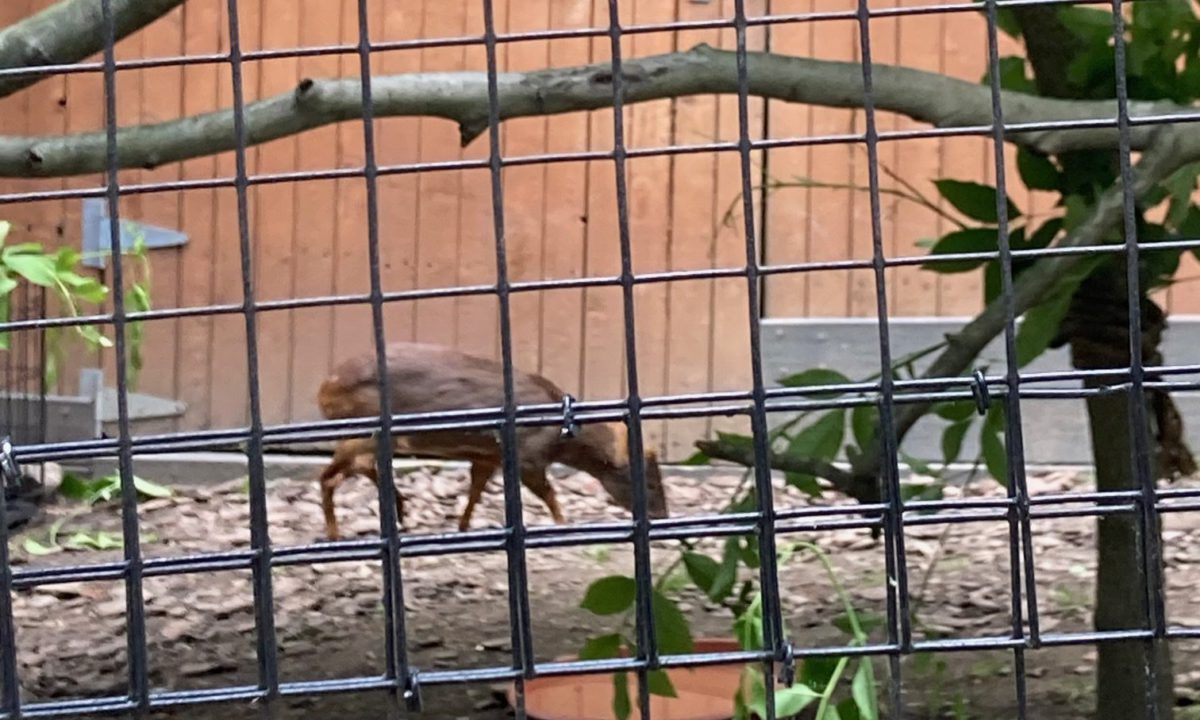This is the story of one man’s stubborn quest to get answers about the death of a tiny celebrity deer.
Haechan, an adult male southern pudu named for a member of Korean boy band NCT, was in Brandywine Zoo’s pudu habitat on the morning of June 24, 2022, when he was observed “lethargic” and “coughing sporadically.” The three-year-old pudu died the following day, just minutes after arrival at Radnor Veterinary Hospital in Wayne, PA.*
Expressions of mourning poured in from far and wide, including from Los Angeles Zoo, where Haechan was born and became world famous after fans of NCT donated to a naming contest.
The southern pudu is the world’s second-smallest deer species (the northern pudu is smaller), native to southern Chile and Argentina. Adult southern pudu typically weigh between 15 and 30 pounds. Males grow seasonal antlers about three inches long.
A little more than a year after Haechan’s death, Brandywine Zoo announced better news: Clover, the zoo’s adult female southern pudu, had given birth after mating with Andre, a male brought from Woodland Park Zoo in Seattle. Both Andre and Haechan had been sent by the Species Survival Plan, a breeding program of the Association of Zoos and Aquariums aimed at conserving vulnerable species.
Yet two months after the birth announcement, the zoo, situated at the foot of Monkey Hill in Wilmington’s Brandywine Park, disclosed that Andre had died of a pox. Clover and her offspring also caught the pox but survived.
For Bob Heiligman, a retired physician in Louisiana who’d heard about Haechan from his K-pop fan daughter, the deaths of Haechan and Andre seemed like more than a coincidence. “I think it’s kind of odd that two male pudus died at the same zoo,” he said.
Suspecting that the deaths might have been caused by human-borne COVID-19, Heiligman filed a Freedom of Information Act (FOIA) request with Delaware’s Department of Natural Resources and Environmental Control, which owns Brandywine Zoo, for a copy of the necropsy (an autopsy for an animal) report for Haechan.
(As an aside, if you’re in Delaware, you perhaps grimaced when you saw the mention of FOIA. And if you guessed that state officials would throw all the bureaucratic indifference they could muster at Heiligman’s request, you’ve probably had a difficult Delaware FOIA experience yourself.)
After filing his FOIA request online with DNREC, Heiligman received a call from “a very nice woman” who asked a few questions. Shortly afterward, Bob received a “form response” denying his request on the grounds that he was “not a citizen of the State of Delaware.”
Heiligman appealed the denial to Delaware’s Office of the Attorney General, pointing out that Brandywine Zoo explicitly aims to attract visitors from beyond Delaware’s narrow borders, or non-citizens in legalese. He was again denied and informed that, as a non-citizen of Delaware, he lacked standing to appeal in the first place.
Undeterred, Heiligman began casting about for a citizen of Delaware to put in the FOIA request for him, eventually landing on the local affiliate of the American Civil Liberties Union, which agreed to act as a go-between. Finally, more than eight months after his first request, Heiligman got the necropsy report.
The necropsy, performed within two days of Haechan’s death at University of Pennsylvania School of Veterinary Medicine’s New Bolton Center in Kennett Square, PA, found that Haechan died of acute kidney disease. An acute illness is one that develops suddenly. That fits with the zoo’s statement that Haechan hadn’t showed outward signs of distress until the day before he died.
But the necropsy also indicated something else: Haechan’s body was emaciated, with fat stores depleted. Heiligman, who had worked in a hospital emergency room and seen emaciated human patients, knew that such a dire condition doesn’t develop in a day.
“How does an animal become emaciated when it has every availability to food and comfort, habitat, protection from predators, protection from severe weather,” he wondered. “You’d think it would have every chance to thrive in terms of its physical well being.”
In an interview with Delaware Call, Dr. Samantha King, a veterinarian who practiced at Brandywine Zoo and other facilities, explained how Haechan could have lost fat before his illness was observed.*
“We cannot always get hands on the animal quickly without stressing the animal out further,” said King.
Haechan was typically “quite stressy,” King said, “very sensitive, not amenable to human interaction, especially in a new location.”
Southern pudu are “normally lean and can lose fat quickly,” King said.
Animal keepers at the zoo noticed Haechan’s condition “immediately, as soon as they arrived on site” on the morning before his death, and they contacted King right away, she said.
“Unfortunately, given the severity of the disease, there just wasn’t much we could do,” she said.
Zoo director Brint Spencer affirmed that no staff members were disciplined over Haechan’s death.
“Our keepers are vigilant almost to a fault,” he said. “I think if there had been any changes in behavior or body condition, it would have been reported.”
King added that because pudu are prey in the wild, Haechan would have instinctively tried to hide any illness “because they know if they were in the wild they’d get picked off.”
“The keepers were devastated. I was devastated,” King said. “We feel this loss just as much, if not more, than any guest who followed him at the LA Zoo.”
At this point, Heiligman finally had an answer to his question about emaciation, but he wasn’t satisfied with it. After King’s comments were relayed to him, Heiligman, who describes himself as “stubborn,” unearthed an edition of Brandywine Zoo’s promotional magazine in which Haechan’s personality is described as “laid back.”
Of course, the same magazine article, which heralded Haechan’s arrival at the zoo in late 2021, erroneously gave his age as four years, a milestone he sadly never reached.
While Heiligman remains unsatisfied with the zoo’s explanation of Haechan’s death, the folks at the Association of Zoos and Aquariums are satisfied with it, said AZA spokeswoman Betsy Hildebrandt.
“Following your inquiry, we reached out to Brandywine to learn more about the circumstances and are satisfied that our accreditation standards wouldn’t have required a report,” Hildebrandt said, via email.
Even after the deaths of Haechan and Andre, a third adult male southern pudu, Teo, has been dispatched to Brandywine Zoo. He came last December from Oakland Zoo in California under the auspices of the AZA’s Species Survival Plan. If all goes well, Teo will mate with Clover and produce offspring.
*Updated on June 6, 2024: After publication of this article, Dr. Len Donato, VDM, owner of Radnor Veterinary Hospital, informed us that Haechan died within five minutes of arriving at the hospital, before the pudu could be evaluated by a staff veterinarian. Separately, after publication of this article, DNREC informed us that Dr. Samantha King, DVM, moved back to New England and no long practices at Brandywine Zoo.

